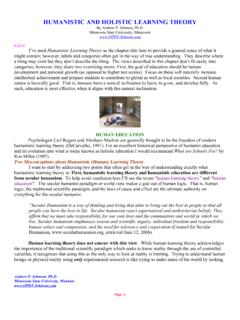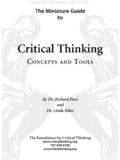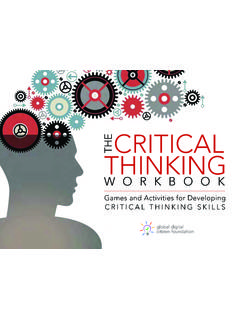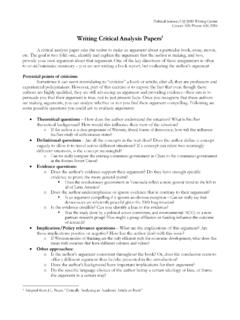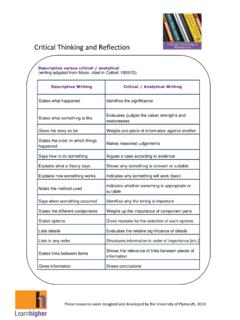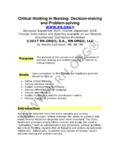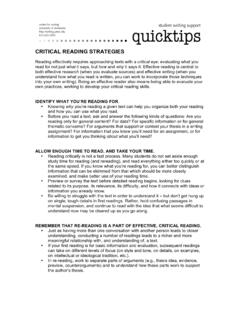Transcription of Chapter 9: Critical and Creative Thinking Skills
1 Chapter 8: Critical and Creative Thinking SkillsTHINKING SKILLSA Thinking skill is any cognitive process that is broken down into steps and explicitly taught (Johnson, 2000). It is different from high-level Thinking , which is simply a complex cognitive process that places high demands on the processing taking place in short-term memory. In contrast, by breaking complex processes into steps, a Thinking skill makes cognitive processes easier to Skills should be introduced and taught using a Thinking frame. A Thinking frame is a concrete representation of a particular cognitive process broken down into specific steps (see Figure ). These should be put up in poster form to facilitate teaching the skill and to help students remember the steps. Figure Thinking frame for Creating analysis/Creating Groups: Students will impose order on a field by identifying and grouping common themes or Frame1.
2 Look at the Identify reoccurring items, themes, or Arrange the parts into Describe the whole in terms of are two types of Thinking Skills : Creative Thinking Skills and Critical Thinking Skills . Critical Thinking involves convergent Thinking or Thinking that converges on a single point. It involves the following types of Thinking processes: organizing, analyzing, evaluating, or using given information to come to a specific Thinking SKILLSC reative Thinking Skills utilize divergent Thinking ; Thinking that diverges from a single point. The following types of cognitive processes are used here: generating ideas, integrating ideas, or seeing things in new ways. The Thinking frames for five Creative Thinking Skills are outlined in Figure Figure Thinking frames for Creative Thinking skillsFluency: Generate as many ideas as possible without Frame1.
3 Look at the idea or Do not worry about good or bad : Connect, combine, or synthesize two or more things to form a new Frame1. Look at all Select interesting or important parts from P. Johnson, State University, Add as many ideas as quickly as you can. Flexibility: Create a variety of different Frame1. Look at the Find other ways for it to be used, solved, or applied. Elaboration: Embellish an original Frame1. Look at the Add things to it to make it better or more : Create new ideas that are unusual or Frame1. Find an idea or Think of solutions or applications that nobody else has thought of Combine to describe a new Web: Create a web to generate ideas relative to a given topic. Thinking Frame1. Look at the original Analyze to identify 2-5 related ideas for Brainstorm to generate ideas for each activities are those in which students generate ideas.
4 Below are some examples of inner curriculum activity ideas that can be used with this Creative Thinking skill. Working individually or in small groups, generate a list of:1. Things or experiences that make you feel a particular emotion (happy, sad, excited, worried, anxious, remorseful, afraid, etc.).2. Symbol ideas for a particular emotion. They would then be used in the creation of poetry, Creative writing , visual art, or Adjectives that describe: you, your day, your week, or your life, 4. Things, experiences, or character traits that you Things to say to somebody who may have hurt you or made you feel People who you People to say thank you Questions you have about Kinds of problems we have. 10. Kinds of problems students in our grade might activities require that students look for a variety of different alternatives or approaches.
5 For example, students could:1. Describe a variety of ways to express an Describe a variety of possible reactions to a particular Describe or express an emotion in a variety of ways. 4. Describe a variety of alternative solutions, approaches, or decisions to a particular situation or requires ones to add to the original, to embellish it in some way, or to make it better. Students here might: 1. Use Creative writing to add to and elaborate on a particular event or experience in their Use a piece of art, poetry, Creative writing , music, or P. Johnson, State University, requires one to create something new. The symbols described in the second idea under fluency could be used to create poetry, Creative writing , visual art, music, or dance. Originality could involve the arts in the form of new works, but it could also involve the sciences in the form of original solutions to human Thinking SKILLSC ritical Thinking involves convergent Thinking ; Thinking that converges on a single point.
6 It involves the following types of cognitive processes: organizing, analyzing, evaluating, or using given information to come to a specific conclusion. The Thinking frames for eight Critical Thinking Skills are outlined in Figure Critical Thinking : Go beyond the available information to identify what may reasonably be Frame1. Identify what is Identify similar situations or important Make a reasonable guess based on 1 and 2. Compare and Contrast: Find similarities and differences between/among two or more Frame1. Look at all Find the Find the Conclude and : Break an item or event down into its component Frame1. Look at the item or Identify important Describe each Describe the whole in terms each partSupporting a Statement: Use appropriate reasons, detail, or examples to support a statement, idea, or Frame1. Make a statement or Gather information/data to support the Organize the Describe the original statement in terms of the new Making: Examine the options and alternatives in order to decide on a course of Frame1.
7 Identify the problem or Generate decision Evaluate costs and rewards of Make a choice based on the : Arrange events, concepts, or items in sequential order based on a Frame1. Look at or define a Look at the Arrange items within the whole according to the Describe the whole in terms of the new : Make a formal critique based on a set of Frame1. Look at or define a Look at the Compare the subject to the Describe the subject relative to the Groups: Impose order on a field by identifying and grouping common themes or Frame1. Look at the Identify reoccurring items, themes, or Arrange into Describe the whole in terms of Web of Comparison. The comparison web uses the Thinking Skills of comparing and contrasting. Students use this to compare and contrast themselves with another person. This person can be from the class, the school, the community, history, or some place in the world.
8 This helps students begin to see the commonality of the human condition. This would be a good warm-up activity for the first weeks of P. Johnson, State University, Figure Comparison DifferencesA comparison web can also be used in class discussions to help people with differing views find common ground. Here, the teacher identifies a topic and then describes it using a dualistic statement. For example, We should have a moment of silence every day in our school. Students initially say if they agree or disagree with this. This can be done with a show of hands, students can state their position as the teacher lists names on the board, or it can be done with a secret ballot. Students are then paired up with a classmate who has the opposite position.
9 They use the web to identify differences and similarities. The ground rule here is that for every difference, they must find something in which both Ordering. Ordering can be used with values clarification activities (see Chapter 5) to rank any item, event, person, experience, or trait according to a given criteria. The Orderizer in Figure can be used here. First, students use the left side of the Orderizer to generate a list of things. Then they examine or define a criterion. The criterion is then used to analyze the list. Students then put the items in order in the right column. Figure :Criteria:generate a them in For example, students could generate a list of (a) inventions from the 1970s and order them from most Andrew P. Johnson, State University, to least significant to their immediate lives; (b) things they have done in the last week and order them from happy to sad; (c) items to take to Mars and order them from most important to least; (d) things to do on a weekend and order them from exciting to boring; (e) things to say to ask somebody out and order them from most usable to least; (f) characters in a story and order from them most like them to least like them.
10 Or (g) solutions to a problem and order them from most pragmatic to least for things to order: events in a story, things done last week, bad experiences, good experience, president, activities, things to take on a trip someplaceIdeas for criteria: Most like them to least like them, happy to sad, important to not important, most valuable to least valuable, near to far, exciting to boring, effective to least effective, or most healthy to least Inferring. Inference is the act of using clues and background knowledge to make some sort of informed conjecture as to what may be true. This can be used with persons or events in a story or in history, and it can also be transferred to personal and real life situations (Johnson, 1996). Figure Infer-O-Gram. Question:what you observe - clueswhat you know - background Inference:For example, in Chapter 1 of the book A Wrinkle in Time (L Engle, 1962), a strange little woman knocks on the door in the middle of a dark, stormy night.
